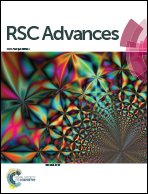Effect of water state and polymer chain motion on the mechanical properties of a bacterial cellulose and polyvinyl alcohol (BC/PVA) hydrogel†
Abstract
In this study, a bacterial cellulose and polyvinyl alcohol (BC/PVA) hydrogel was developed. The compressive modulus of the composite hydrogel increased by enhancing the content of BC and/or PVA and increased significantly by increasing the PVA content to 20 wt%. However, the strain point of the initial compressive failure decreased as the BC content increased. Using a simple and novel method that compares the compressive moduli of dehydrated and original samples, the compressive modulus decreased unexpectedly in dehydrated samples with PVA contents exceeding 20 wt%; in dehydrate samples with PVA contents of less than 20 wt%, the results increased. According to differential scanning calorimetry (DSC) results, free water was transformed to freezable bound water within the composite hydrogels when the PVA content was increased to greater than 20 wt%. Thus, freezable bound water has a greater effect on the compressive modulus of the composite hydrogel than free water and plays a significant role in maintaining the flexibility and stiffness of the hydrogel. Differences in the polymer chain motion and elastic modulus between the composite and pure PVA hydrogels were also studied using dynamic mechanical analysis (DMA). The results demonstrated that the molecular chain relaxation and viscosity were lower and that the elastic modulus was higher for BC/PVA than for pure PVA, indicating that the PVA molecular chain of the BC/PVA composite tends to be rigid, possibly contributing to the marked improvement in the mechanical properties.


 Please wait while we load your content...
Please wait while we load your content...